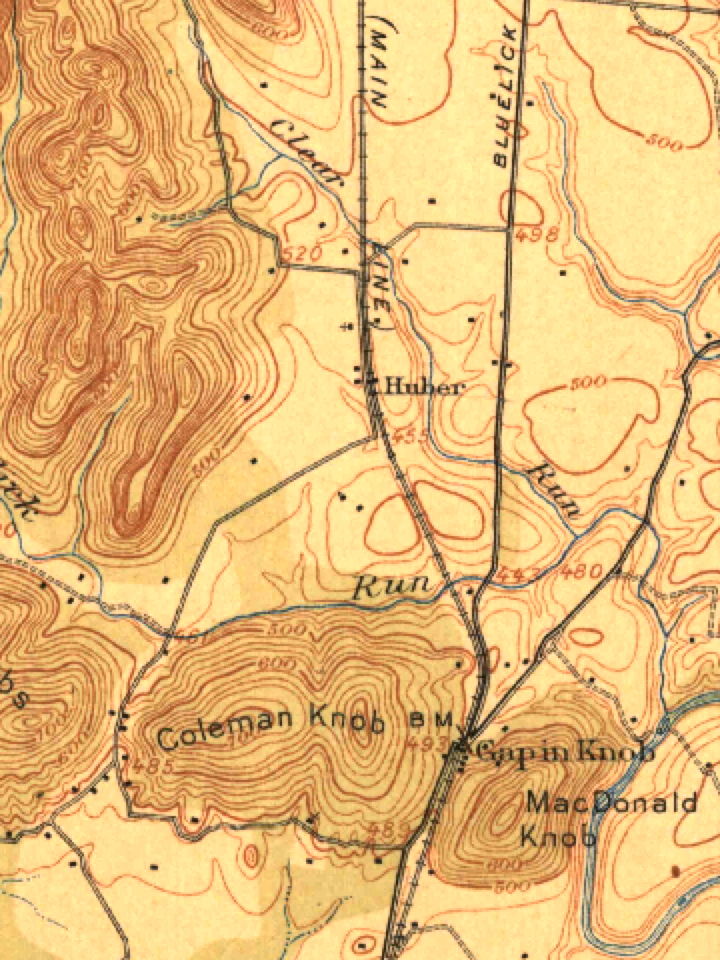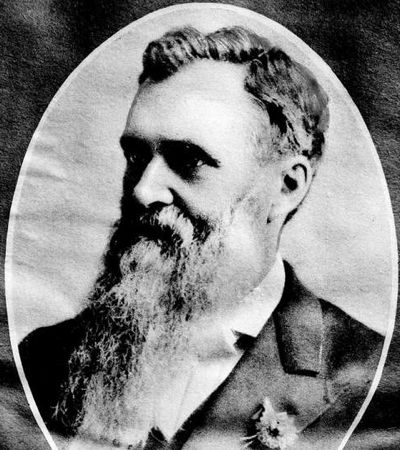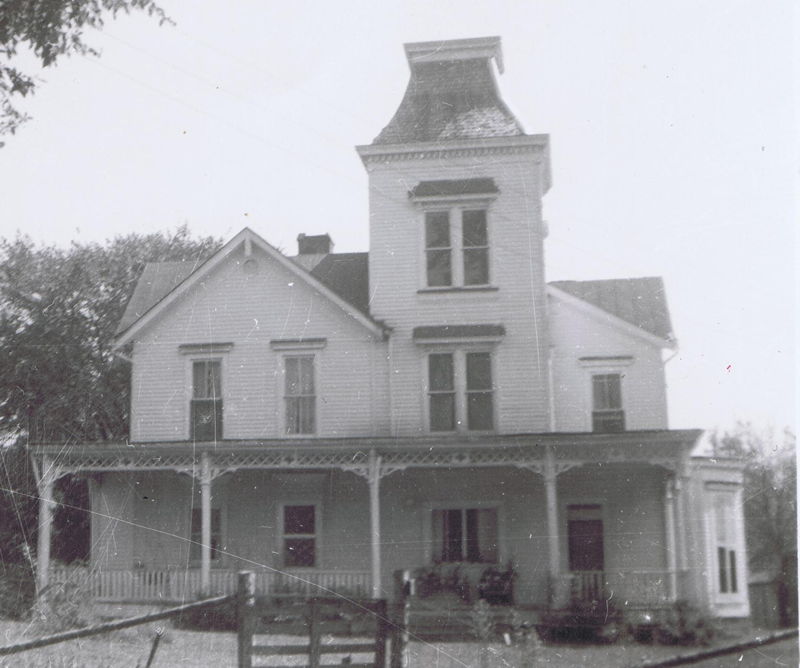
The following article by Charles Hartley was originally published on 11 Apr 2012. It has been recently updated.
A quiet stretch of Coral Ridge Road (Highway 1020), to the west of the CSX railroad tracks, parallels a residential street to the east named Huber Station Road which enters East Blue Lick Road near where the 2011 train derailment occurred.

In that derailment, 17 of a 48-car CSX train left the tracks about 3 p.m., on June 30th. The train was carrying more than 200 new cars and trucks inside the derailed cars. Fortunately no one was injured in this wreck.
According to reports, the accident was caused by a rail damaged by a tractor-trailer that had struck the rail while backing up to turn around on Coral Ridge road at Blue Lick road near the tracks.
This area has received considerable attention in recent years, with a fiery train wreck in 2007 in almost the same location of the more recent one.
This one occurred on January 16th when 25 cars left the tracks at about 8:45 a.m., with at least 14 catching fire, most of those containing hazardous materials. Nearby schools were closed, and residents were forced to flee their homes. The drifting smoke caused Interstate 65 to be closed for a time.
Besides the massive clean-up effort by CSX, the Louisville Water Company replaced the water line to the area to ensure that the supply had not been contaminated by chemicals escaping from the wrecked cars.
More than a month later, nearby residents were still waiting to return to their homes along Hubers Station Road.
With a name like Hubers Station Road, and a location next to a railroad track, you would think there must have been a train station close by at one time, and you'd be right.
The system, then know as the Louisville & Nashville Railroad, reached this area in the mid 1850's, and by 1860 provided rail transportation between its two namesake cities.
As it traveled through the northern part of Bullitt County it passed through a farming area just to the east of the knobs region, and then dove between Coleman and MacDonald Knobs in a space that is appropriately called "Gap in Knob," coming out just north of Shepherdsville. [See map.]
At the time, the tracks passed through the gap, but was required to rise and then descend in both directions as it passed the gap. Later, the passageway was leveled out by lowering the track bed. Today, the gap itself is being widened, and a new highway bridge is being constructed over the tracks as Preston Highway is expanded. But, that's another story.
While some families already lived in the area, others from Louisville were quick to see the potential here for summer homes in the country. One such family was that of James Henry Huber.
The son of a Presbyterian minister, Huber joined the business world early, working first as a clerk in the office of an iron furnace at Shepherdsville. After a short time he became their bookkeeper.
Moving to Louisville, Huber became a partner in the music and instrument house of D. P. Faulds & Company, but sold out his interests there to enlist in the Mexican war about 1847.

After that war, he returned to Louisville and worked for various companies. During this time he joined a group of men who obtained a state charter in 1854 to organize the "Young Men's Christian Association of Louisville," and served as the organization's first president.
When the Civil War broke out in 1861, he was a senior clerk for the Hamilton Company, one of Louisville's pork packers. When the Hamilton Company established a banking house, Huber became its cashier. The bank would later become known as the People's Bank of Kentucky.
In 1866, Huber purchased 333 acres of land along the railroad in Bullitt County from the estate of Charles Q. Armstrong. He soon moved his large family to their new country home.
In those days, it was more convenient to ride the train between Louisville and Shepherdsville than to travel the rough roads. The local trains would often stop in rural areas to allow passengers to board or depart near their homes. Huber didn't waste time before convincing the railroad to build a small depot on his land, and it was finished by June 1871; thus Huber's Station was born.

Huber also had ambitious plans for the area. Together with George Shanklin, John O. Harrison, and Henry C. Pindell, he obtained a charter from the General Assembly in 1870 to organize a residential community known as Knoll Park on up to 3,000 acres of land just north of the Gap in Knob railroad station. However, there is little evidence that this development prospered.
Huber continued to work as the bank's cashier for over thirty years, traveling daily between his home and Louisville. During that time Huber's Station was a regular stop on the railroad for the local trains that traveled from Louisville to Springfield by way of Shepherdsville and Bardstown.
In 1893 the small bank concluded that it could no longer be profitable, and after settling its affairs, James Huber closed its doors in March 1894.
His health had been deteriorating in recent months, and he was diagnosed with "softening of the brain." While the disease made it increasingly difficult for him to function intellectually, he was still able to get about, and he enjoyed taking morning walks along the platform at the station.
On the morning of April 27, 1894, a train engineer saw a figure walking on the track about one hundred feet south of the platform and in the direction the train was running. The man did not leave the track and the engineer blew the whistle of his engine. Then he applied the air brake but to little avail. The distance was too short to stop, and while running at good speed the engine struck the man, tossing him from the tracks and killing him.
Thus ended the life of James Henry Huber. His widow, Henrietta Douglas Huber, and her remaining children at home, continued to live in the small community. Henrietta died shortly after Christmas 1900, but the Huber home continued to be occupied by her daughter Mary and her husband, Francis J. Hagan. Then, in October 1903, following a bitter dispute with a neighbor, the Hagans sold the land around the depot to Ben Shepherd, and moved to Montgomery, Alabama.
Francis Hagan returned in August 1904 to sell the last of their Bullitt County land. In a final encounter at the depot he was fatally wounded by John Barbour. (Follow this link for more details.)
Thus ended the connection with the Huber family and the little station that bore their name. Trains continued to stop there for a few years more, but within a decade it saw few trains stop at its door. Today no passenger trains come this way. Only the memory of a long-gone depot is there to watch the future go by.
Copyright 2017 by Charles Hartley, Shepherdsville KY. All rights are reserved. No part of the content of this page may be included in any format in any place without the written permission of the copyright holder.
The Bullitt County History Museum, a service of the Bullitt County Genealogical Society, is located in the county courthouse at 300 South Buckman Street (Highway 61) in Shepherdsville, Kentucky. The museum, along with its research room, is open 10 a.m. to 4 p.m. Monday through Friday. Saturday appointments are available by calling 502-921-0161 during our regular weekday hours. Admission is free. The museum, as part of the Bullitt County Genealogical Society, is a 501(c)3 tax exempt organization and is classified as a 509(a)2 public charity. Contributions and bequests are deductible under section 2055, 2106, or 2522 of the Internal Revenue Code. Page last modified: 12 Sep 2024 . Page URL: bullittcountyhistory.org/memories/huberstation.html